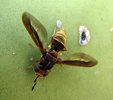Hermetia
Keith Bayless- Hermetia aeneipennis
- Hermetia albipoda
- Hermetia albitarsis
- Hermetia amboyna
- Hermetia ampulla
- Hermetia amsarii
- Hermetia anthidium
- Hermetia aurata
- Hermetia aurinotata
- Hermetia austeni
- Hermetia beebei
- Hermetia bicolor
- Hermetia borneensis
- Hermetia brunettii
- Hermetia burmeisteri
- Hermetia callifera
- Hermetia ceria
- Hermetia ceriogaster
- Hermetia cerioides
- Hermetia chrysopila
- Hermetia cingulata
- Hermetia coarctata
- Hermetia comstocki
- Hermetia concinna
- Hermetia condor
- Hermetia confidens
- Hermetia conjuncta
- Hermetia cornithorax
- Hermetia crabro
- Hermetia currani
- Hermetia eiseni
- Hermetia femoralis
- Hermetia fimbriata
- Hermetia flavipes
- Hermetia flavoscutata
- Hermetia formica
- Hermetia fulva
- Hermetia geniculata
- Hermetia goncalvesi
- Hermetia hunteri
- Hermetia illucens
- Hermetia impressa
- Hermetia inflata
- Hermetia itatiaiensis
- Hermetia jamesi
- Hermetia laeta
- Hermetia laglaizei
- Hermetia lativentris
- Hermetia malaana
- Hermetia melanderi
- Hermetia mitis
- Hermetia myieriades
- Hermetia nana
- Hermetia nigra
- Hermetia nigricornis
- Hermetia pallidipes
- Hermetia palmivora
- Hermetia panamaensis
- Hermetia panhagensis
- Hermetia pectoralis
- Hermetia pennicornis
- Hermetia pterocausta
- Hermetia pulchra
- Hermetia reinhardi
- Hermetia relicta
- Hermetia remittens
- Hermetia rufitarsis
- Hermetia ryckmani
- Hermetia samoensis
- Hermetia scutellata
- Hermetia sexmaculata
- Hermetia sphecodes
- Hermetia subpellucida
- Hermetia teevani
- Hermetia tincta
- Hermetia virescens
- Hermetia virgata
- Hermetia woodleyi
Introduction
Hermetia illucens is a cosmopolitan synanthrope. H. illucens has been the culprit in several cases intestinal myiasis (James 1981). Numerous other species of Hermetia are wasp mimics. H. pterocausta maintain small territories on leaves of short palms in gaps of light. H. pterocausta was observed on Barro Colorado Island (Panama) to dart out from their territories to intercept any objects similar in size to the fly. H. palmivora is considered a pest of oil palms (Woodley 2001).
Hermetia illucens is the only species found in Europe. 4 species are found in the Afrotropical region, 10 in Australasian, 12 in the Nearctic, 14 in the Oriental region, and the rest of the described species in Central and South America. H. panhagensis and H. woodleyi are from Malaysia (Woodley 2001).
Characteristics
Hermetia is distinguished by the laterally flattened eighth antennal flagellomere (Woodley 2001).References
James, M.T. 1981. 36. Stratiomyidae. Manual Nearct. Dipt. 1: 497-511.
Rozkošný, R. and M. Kozanek. 2006. A review of the Oriental Hermetia bicolor group with descriptions of two new species (Diptera: Stratiomyidae). Insect Syst. Evol. 37: 81-90.
Woodley, N. E. 2001. A World Catalog of the Stratiomyidae (Insecta: Diptera). Myia 11: 1-473. Backhuys Publishers, Leiden.
Information on the Internet
- Harvard MCZ Type Images. Images of Hermetia ampulla.
- Harvard MCZ Type Images. Images of Hermetia chrysopila.
- Harvard MCZ Type Images. Images of Hermetia flavipes.
Title Illustrations

| Scientific Name | Hermetia comstocki |
|---|---|
| Location | Tucson, Pima County, Arizona, USA |
| Comments | on opuntia |
| Specimen Condition | Live Specimen |
| Image Use |
 This media file is licensed under the Creative Commons Attribution-NonCommercial License - Version 3.0. This media file is licensed under the Creative Commons Attribution-NonCommercial License - Version 3.0.
|
| Copyright |
© 2008

|
About This Page
Keith Bayless

North Carolina State University, Raleigh, North Carolina, USA
Correspondence regarding this page should be directed to Keith Bayless at
Page copyright © 2008 Keith Bayless
All Rights Reserved.
- First online 28 September 2008
- Content changed 28 September 2008
Citing this page:
Bayless, Keith. 2008. Hermetia. Version 28 September 2008 (under construction). http://tolweb.org/Hermetia/108747/2008.09.28 in The Tree of Life Web Project, http://tolweb.org/








 Go to quick links
Go to quick search
Go to navigation for this section of the ToL site
Go to detailed links for the ToL site
Go to quick links
Go to quick search
Go to navigation for this section of the ToL site
Go to detailed links for the ToL site